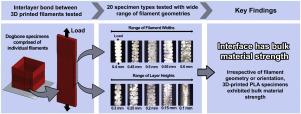Additive Manufacturing ( IF 10.3 ) Pub Date : 2020-05-11 , DOI: 10.1016/j.addma.2020.101297 James Allum , Amirpasha Moetazedian , Andrew Gleadall , Vadim V. Silberschmidt

|
This study demonstrates that the interface between layers in 3D-printed polylactide has strength of the bulk filament. Specially designed 3D-printed tensile specimens were developed to test mechanical properties in the direction of the extruded filament (F specimens), representing bulk material properties, and normal to the interface between 3D-printed layers (Z specimens). A wide range of cross-sectional aspect ratios for extruded-filament geometries were considered by printing with five different layer heights and five different extruded-filament widths. Both F and Z specimens demonstrated bulk material strength. In contrast, strain-at-fracture, specific load-bearing capacity, and toughness were found to be lower in Z specimens due to the presence of filament-scale geometric features (grooves between extruded filaments). The different trends for strength as compared to other mechanical properties were evaluated with finite-element analysis. It was found that anisotropy was caused by the extruded-filament geometry and localised strain (as opposed to assumed incomplete bonding of the polymer across the interlayer interface). Additionally, effects of variation in print speed and layer time were studied and found to have no influence on interlayer bond strength. The relevance of the results to other materials, toolpath design, industrial applications, and future research is discussed. The potential to use this new understanding to interpret historic and future research studies is also demonstrated.
中文翻译:

层间粘合在挤出增材制造中具有整体材料强度:对各向异性的新认识
这项研究表明3D打印的聚丙交酯中各层之间的界面具有散装长丝的强度。开发了专门设计的3D打印拉伸标本,以测试在挤出长丝方向上的机械性能(F标本),代表了散装材料的性能,并垂直于3D打印层之间的界面(Z标本)。通过以五种不同的层高和五种不同的挤压丝宽度进行印刷,可以考虑到挤压丝几何形状的各种横截面纵横比。F和Z样品均显示出块体材料强度。相比之下,由于长丝尺寸的几何特征(挤压长丝之间的沟槽)的存在,Z样品的断裂应变,比承载力和韧性较低。与其他机械性能相比,强度的不同趋势通过有限元分析进行了评估。发现各向异性是由挤出丝的几何形状和局部应变引起的(与假定的跨层界面的聚合物不完全结合相反)。另外,研究了印刷速度和层时间变化的影响,发现对层间粘合强度没有影响。讨论了结果与其他材料,刀具路径设计,工业应用和未来研究的相关性。还展示了使用这种新的理解来解释历史和未来研究的潜力。发现各向异性是由挤出丝的几何形状和局部应变引起的(与假定的跨层界面的聚合物不完全结合相反)。另外,研究了印刷速度和层时间变化的影响,发现对层间粘合强度没有影响。讨论了结果与其他材料,刀具路径设计,工业应用和未来研究的相关性。还展示了使用这种新的理解来解释历史和未来研究的潜力。发现各向异性是由挤出丝的几何形状和局部应变引起的(与假定的跨层界面的聚合物不完全粘合相反)。另外,研究了印刷速度和层时间变化的影响,发现对层间粘合强度没有影响。讨论了结果与其他材料,刀具路径设计,工业应用和未来研究的相关性。还展示了使用这种新理解来解释历史和未来研究的潜力。讨论了结果与其他材料,刀具路径设计,工业应用和未来研究的相关性。还展示了使用这种新理解来解释历史和未来研究的潜力。讨论了结果与其他材料,刀具路径设计,工业应用和未来研究的相关性。还展示了使用这种新理解来解释历史和未来研究的潜力。









































 京公网安备 11010802027423号
京公网安备 11010802027423号